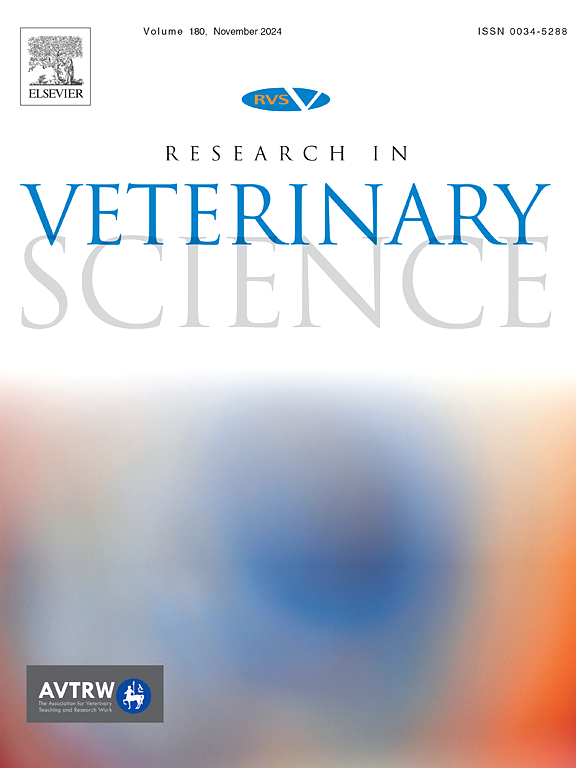Assessing the inflammatory response in horses undergoing gastric ulceration using salivary ADA and S100A12 as biomarkers
IF 2.2
3区 农林科学
Q1 VETERINARY SCIENCES
引用次数: 0
Abstract
The inflammatory status in horses with gastric ulcers was monitored by two inflammatory biomarkers, S100A12 and adenosine deaminase (ADA), using saliva samples from healthy and horses with gastric ulcers. Two trials were developed: an experimental trial, in which gastric ulceration was induced in 8 horses by feed deprivation, and a clinical trial, in which 20 horses without any symptomatology and 37 with symptoms compatible with gastric ulcers were used. S100A12 and ADA levels were measured in the saliva samples of all horses using previously validated assays. In both trials, horses with gastric ulcers had higher levels of S100A12 and ADA than healthy horses, demonstrating that inflammation is involved in the pathophysiology of gastric ulcers in horses. An intense reaction of ADA with a moderate increase of S100A12 was detected in the experimental trial, while different intensities in the inflammatory biomarkers were observed in clinical conditions when the ulcers were divided by gastric localization in glandular (EGGD) and squamous (ESGD). Since ADA has been shown to be released early in the inflammatory process and S100A12 is released later, by measuring them together we could more accurately assess the inflammatory process in equine gastric ulcers. Furthermore, a strong association was found between ADA and S100A12 (correlation coefficient of 0.84) in the experimental trial, while it was low-moderate (correlation coefficient of 0.39) in the clinical trial. Therefore, it could be concluded that both salivary biomarkers provide valuable information about the inflammation involved in gastric ulcers of horses and the state of the process.
使用唾液ADA和S100A12作为生物标志物评估胃溃疡马的炎症反应
使用健康和胃溃疡马的唾液样本,通过两种炎症生物标志物S100A12和腺苷脱氨酶(ADA)监测胃溃疡马的炎症状态。开展了两项试验:一项是实验试验,其中8匹马被剥夺饲料引起胃溃疡;另一项是临床试验,其中20匹马没有任何症状,37匹马的症状与胃溃疡相符。使用先前验证的分析方法测量所有马唾液样本中的S100A12和ADA水平。在两项试验中,患有胃溃疡的马的S100A12和ADA水平都高于健康的马,这表明炎症参与了马胃溃疡的病理生理。在实验试验中检测到ADA的强烈反应,S100A12适度升高,而在临床条件下,溃疡按胃定位腺状(EGGD)和鳞状(ESGD)划分时,炎症生物标志物的强度不同。由于ADA在炎症过程中释放较早,而S100A12在炎症过程中释放较晚,因此通过测量它们,我们可以更准确地评估马胃溃疡的炎症过程。此外,在实验试验中,ADA与S100A12呈强相关性(相关系数为0.84),而在临床试验中,ADA与S100A12呈低-中度相关性(相关系数为0.39)。因此,可以得出结论,这两种唾液生物标志物提供了有关马胃溃疡炎症及其过程状态的有价值的信息。
本文章由计算机程序翻译,如有差异,请以英文原文为准。
求助全文
约1分钟内获得全文
求助全文
来源期刊

Research in veterinary science
农林科学-兽医学
CiteScore
4.40
自引率
4.20%
发文量
312
审稿时长
75 days
期刊介绍:
Research in Veterinary Science is an International multi-disciplinary journal publishing original articles, reviews and short communications of a high scientific and ethical standard in all aspects of veterinary and biomedical research.
The primary aim of the journal is to inform veterinary and biomedical scientists of significant advances in veterinary and related research through prompt publication and dissemination. Secondly, the journal aims to provide a general multi-disciplinary forum for discussion and debate of news and issues concerning veterinary science. Thirdly, to promote the dissemination of knowledge to a broader range of professions, globally.
High quality papers on all species of animals are considered, particularly those considered to be of high scientific importance and originality, and with interdisciplinary interest. The journal encourages papers providing results that have clear implications for understanding disease pathogenesis and for the development of control measures or treatments, as well as those dealing with a comparative biomedical approach, which represents a substantial improvement to animal and human health.
Studies without a robust scientific hypothesis or that are preliminary, or of weak originality, as well as negative results, are not appropriate for the journal. Furthermore, observational approaches, case studies or field reports lacking an advancement in general knowledge do not fall within the scope of the journal.
 求助内容:
求助内容: 应助结果提醒方式:
应助结果提醒方式:


